
Paradoris cf. lopezi
Order: NUDIBRANCHIA
Suborder: DORIDINA
Superfamily: EUDORIDOIDEA
Family: Discodorididae
DISTRIBUTION
Known only from the Galapagos Ids
PHOTO
Locality: Galapagos Islands, 15 meters, Gordon Rocks near Santa Cruz Is, Pacific Ocean, 17 November 2007, Steep wall dive . Length: approx. 10 cm. Photographer: Roland Brookes.
This is a spectacularly coloured dorid which from earlier messages to the Forum is not that uncommon in the Galapagos Ids. However as you will see from the earlier mesages, which are attached below, it seems to be unnamed.
However quite recently a small dorid was named from the Pacific coast of Mexico as Paradoris lopezi and I am beginning to wonder if it is a small example of the Galapagos animal? Paradoris lopezi was described from a few small animals, 30 mm long, so it is possible that it has yet to develop its brilliant orange red border. It has reddish tubercles on the back and traces of a red mantle border, and the rhinophore and gill pockets have raised sheaths like in the Galapagos animals. It also has the same pitted granular texture on the mantle skin which we find in species of Paradoris.
I may be wrong, but at least raising the possibility that this is the adult form of P. lopezi may draw attention again to this spectacular animal. As always, comments are welcome.
Authorship detailsRudman, W.B., 2008 (February 11) Paradoris cf. lopezi [In] Sea Slug Forum. Australian Museum, Sydney. Available from http://www.seaslugforum.net/find/paracflope
Related messages
Dorid from Galapagos Ids - Paradoris lopezi?
February 11, 2008
From: Roland Brookes
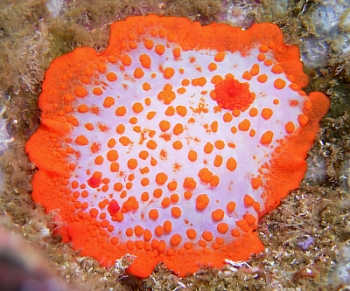
Hi
I took this photo on a recent trip to the Galapagos Islands. Could you tell me what it is? Is it a nudibranch? I have a nudibranch book by Debelius (Nudibranchs and Sea Snails Indo-Pacific field guide)and it looks similar in shape to a Halgerididae; in particular Asteronotus cespitosus (on page 259)although the colours and location are different.
Locality: Galapagos Islands, 15 meters, Gordon Rocks near Santa Cruz Is, Pacific Ocean, 17 November 2007, Steep wall dive . Length: approx. 10 cm. Photographer: Roland Brookes.
Any help would be greatly appreciated.
Roland
rolandbrookes@hotmil.co.uk
Brookes, R.C., 2008 (Feb 11) Dorid from Galapagos Ids - Paradoris lopezi?. [Message in] Sea Slug Forum. Australian Museum, Sydney. Available from http://www.seaslugforum.net/find/21269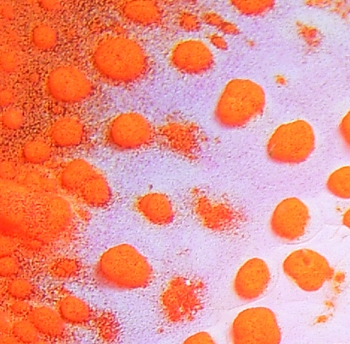
Dear Roland,
This is a spectacularly coloured dorid which from earlier messages to the Forum is not that uncommon in the Galapagos Ids. However as you will see from the earlier mesages, which are attached below, it seems to be unnamed.
However quite recently a small dorid was named from the Pacific coast of Mexico as Paradoris lopezi and I am beginning to wonder if it is a small example of the Galapagos animal? Paradoris lopezi was described from a few small animals, 30 mm long, so it is possible that it has yet to develop its brilliant orange red border. It has reddish tubecles on the back and traces of a red mantle border, and the rhinophore and gill pockets have raised sheaths like in the Galapagos animals. It also has the same pitted granular texture on the mantle skin which we find in species of Paradoris.
I may be quite wrong but I have moved all the earlier messages from the 'unidentified pages' and linked them, with yours, to a Paradoris cf. lopezi page. At present all the earlier records of this animal from the Galapagos Ids are lost amongst the unidentified species, so this is a way to again draw attention to this spectacular animal. As always, comments are welcome.
Best wishes,
Bill Rudman
Unidentified dorid from the Galapagos Ids
October 9, 2007
From: Fontaine Denton
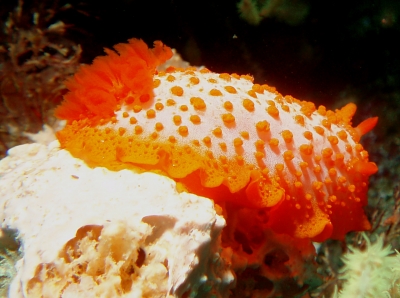
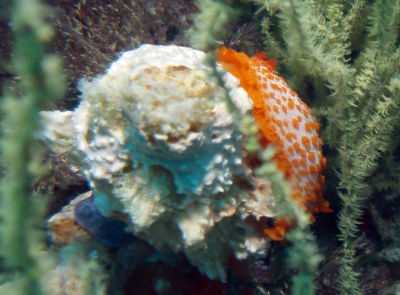
My wife and I found this nudibranch in the southern Galapagos at about 65 feet on the wall under an overhang, it was in August. We can not find the species in the Galapagos ID book or our sea slug ID book for the indo pacific. Can you please identify it for us??
Locality: Southern Galapagos, 65-70 feet, Ecuador, Pacific, August 2007, Wall overhang. Length: 2.5-3 inches. Photographer: Fontaine and Maxine Denton.
Fontaine Denton
fontainedenton@yahoo.com
Denton, F., 2007 (Oct 9) Unidentified dorid from the Galapagos Ids. [Message in] Sea Slug Forum. Australian Museum, Sydney. Available from http://www.seaslugforum.net/find/20905
Dear Fontaine,
This is the third report of this strangely beautiful dorid nudibranch from the Galapagos Ids [see message #20277]. I have checked with colleagues worldwide and the consensus is that this is an unnamed species, but as to a genus or family, I think we need to wait until someone collects some specimens and some expert is able to study its anatomy. The damage to the whitish sponge in your photos suggests it is a sponge-feeding species, feeding on this white sponge. However in the upper photo it looks like there is an orange sponge as well, and in the lower photos there seems to be an orange egg ribbon.
I can't really say much more. It is strange that such a brightly coloured species has not been recorded until the first record on the Forum [#10643 ] in 2003, where it was on the same whitish sponge.
Best wishes,
Bill Rudman
Dorid? from Galapagos Islands
July 24, 2007
From: Joshua Feingold

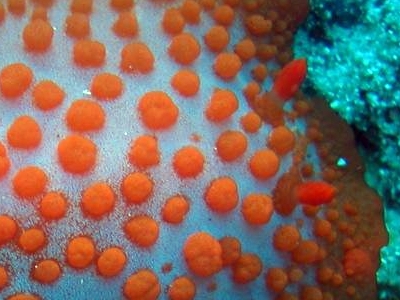
During a recent dive in the southerrn Galapagos Archipelago, I observed this beautiful nudibranch. Marine scientists at the Charles Darwin Research Station and colleagues in the USA have not yet been able to identify it.
Locality: North coast, Floreana Island, 25 m, Galapagos Islands, Ecuador, East Pacific, 9 June 2007, On rubble patch on hard bottom community. Length: 10 cm. Photographer: Joshua Feingold.
Thank you for your help.
Cheers,
Joshua Feingold
Nova Southeastern University
joshua@nova.edu
Feingold, J.S., 2007 (Jul 24) Dorid? from Galapagos Islands. [Message in] Sea Slug Forum. Australian Museum, Sydney. Available from http://www.seaslugforum.net/find/20277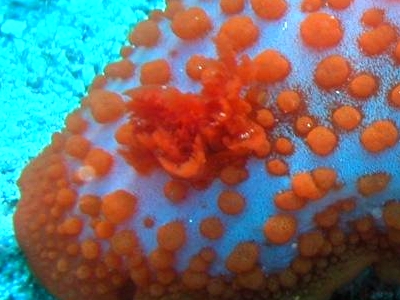
Dear Joshua,
This is the second report of this strange and spectacular species from the Galapagos Ids [see message #10643 ], and the first message did not result in any brilliant suggestions from Forum participants. I had wondered if it was a weird polycerid of some sort but your photo shows that the mantle skirt extends all the way around the body. Michael Schroedl has had an exhaustive look at old names for South American species [see Sea Slugs of southern South America ] and I can't see anything there which looks vaguely like your animal. If we are lucky, someone who missed the first message will recognise your photo - but that may be optimistic.
Best wishes,
Bill Rudman
Re: Nudibranch? from the Galapagos Ids
August 16, 2003
From: Angel Chiriboga

Dear Dr. Rudman,
Thanks for your reply. It was between 10 to 15 cm long. It was on a sponge - an unidentified sponge (I'm also sending a picture) that was on a black coral (Anthipathes galapagensis).
I'm also sending you a close-up of what I think is the rhinophore. I hope you find these useful
Best regards
Angel Chiriboga
achiriboga@fcdarwin.org.ec
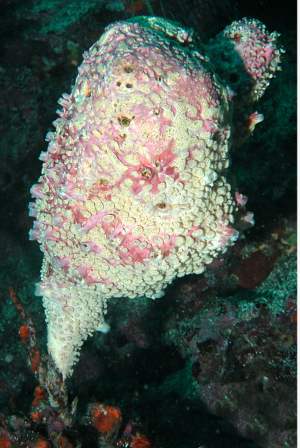

Dear Angel,
Thanks for the photos. Your sponge certainly is distinctive but I don't know if it has any relevance to the mystery 'slug'. The object you identify as a possible rhinophore certainly could be a rhinophore, but I still have no idea what it is.
Best wishes
Bill Rudman
Nudibranch? from the Galapagos Ids
August 15, 2003
From: Angel Chiriboga
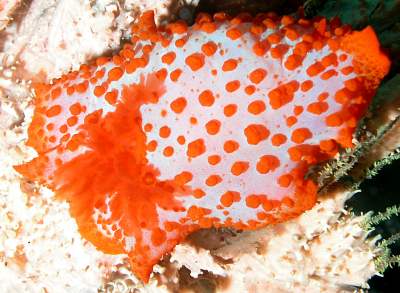
Dear Dr. Rudman,
This species was seen at Guy Fawkes, Santa Cruz (Galapagos Archipielago), July 2003 at 80ft on a sponge.
I hope you can help me with the ID.
Best wishes
Angel Chiriboga
achiriboga@fcdarwin.org.ec

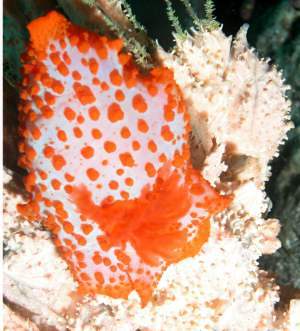
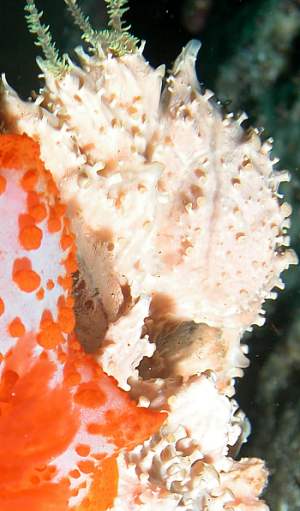
Dear Angel,
I have included an enlargement alongside to show the sponge you found this animal on. I am not sure this is a nudibranch. There seems to be a cluster of orange gills on the back, but I can't see any rhinophores or recognisable 'head' at the other end so I can't be sure. One possibility is a polycerid such as Triopha. Perhaps the 'gills' are the feeding tentacles of a Sea Cucumber?
Without a better idea of its shape I can't say much more. Hopefully someone with knowledge of the eastern Pacific fauna will recognise this from its very spectacular colour
Best wishes,
Bill Rudman
